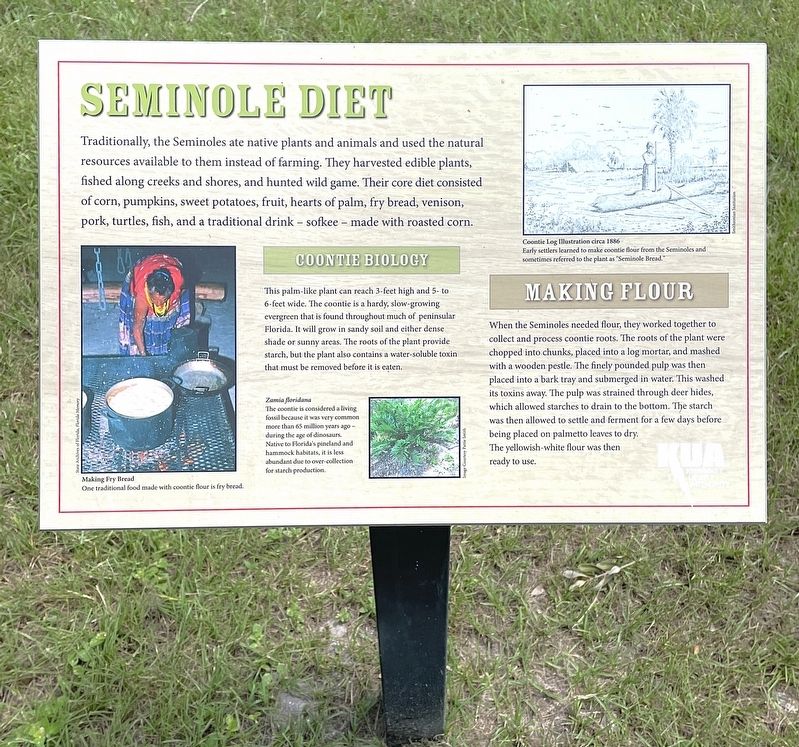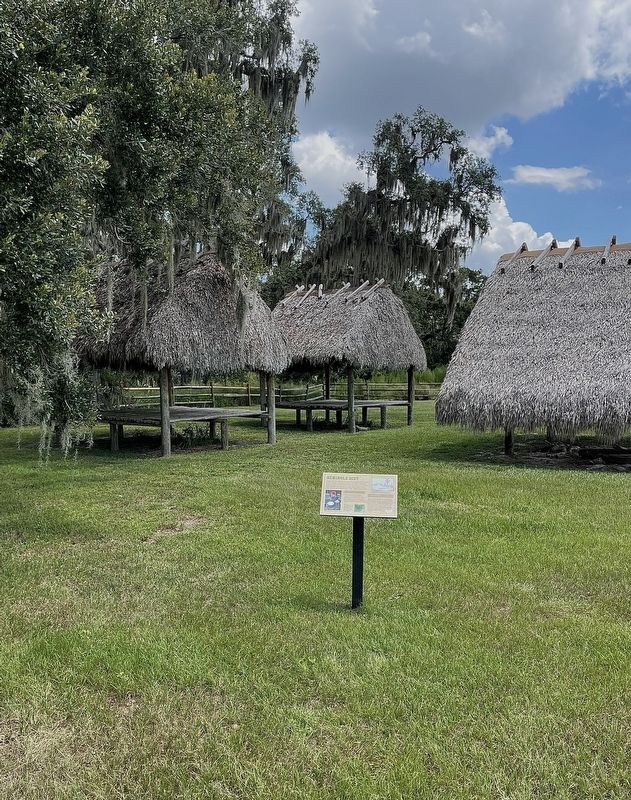Kissimmee in Osceola County, Florida — The American South (South Atlantic)
Seminole Diet
— Pioneer Village at Shingle Creek —
Coontie Biology
This palm-like plant can reach 3-feet high and 5 to 6-feet wide. The coontie is a hardy, slow-growing evergreen that is found throughout much of peninsular Florida. It will grow in sandy soil and either dense shade or sunny areas. The roots of the plant provide starch, but the plant also contains a water-soluble toxin that must be removed before it is eaten.
Making Flour
When the Seminoles needed flour, they worked together to collect and process coontie roots. The roots of the plant were chopped into chunks, placed into a log mortar, and mashed with a wooden pestle. The finely pounded pulp was then placed into a bark tray and submerged in water. This washed its toxins away. The pulp was strained through deer hides, which allowed starches to drain to the bottom. The starch was then allowed to settle and ferment for a few days before being placed on palmetto leaves to dry. The yellowish-white flour was then ready to use.
(captions)
Making Fry Bread
One traditional food made with coontie flour is fry bread.
Photo courtesy State Archives of Florida, Florida Memory
Zamia floridana
The coontie is considered a living fossil because it was very common more than 65 million years ago — during the age of dinosaurs. Native to Florida's pineland and hammock habitats, it is less abundant due to over-collection for starch production
Image courtesy Pattie Smith
Coontie Log Illustration circa 1886
Early settlers learned to make coontie floor from the Seminoles and sometimes referred to the plant as “Seminole Bread.”
Smithsonian Institution
Erected by City of Kissimmee and Osceola County.
Topics. This historical marker is listed in these topic lists: Agriculture • Native Americans • Settlements & Settlers.
Location. 28° 19.124′ N, 81° 27.32′ W. Marker is in Kissimmee, Florida, in Osceola County. Marker can be reached from Babb Road, 0.2 miles north of Princess Lane. Marker located within the Pioneer Village at Shingle Creek. Touch for map. Marker is at or near this postal address: 2491 Babb Road, Kissimmee FL 34746, United States of America. Touch for directions.
Other nearby markers. At least 8 other markers are within walking distance of this marker. Seminole Settlement: Life on Higher Ground (a few steps from this marker); Hide Traders (within shouting distance of this marker); Cow Camps (within shouting distance of this marker); A British Officer Finds Paradise in Florida (within shouting distance of this marker); James C. Tyson: A Florida Cracker (within shouting distance of this marker); Radcliffe Cadman Bros. Packing House (within shouting distance of this marker); Congregations (within shouting distance of this marker); The Village Depot (within shouting distance of this marker). Touch for a list and map of all markers in Kissimmee.
Also see . . . Pioneer Village at Shingle Creek. (Submitted on September 3, 2022, by Brandon D Cross of Flagler Beach, Florida.)
Credits. This page was last revised on April 13, 2023. It was originally submitted on September 3, 2022, by Brandon D Cross of Flagler Beach, Florida. This page has been viewed 139 times since then and 38 times this year. Last updated on April 12, 2023, by Steven Owens of Lake Alfred, Florida. Photos: 1, 2. submitted on September 3, 2022, by Brandon D Cross of Flagler Beach, Florida. • Bernard Fisher was the editor who published this page.

